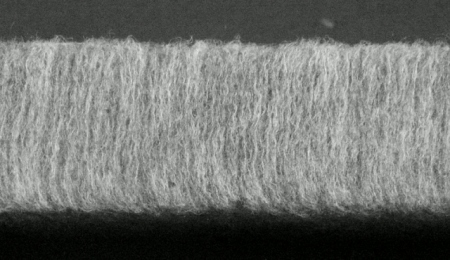Teijin Limited announced that its V-Lap lightweight, sound-absorbing polyester material has been selected for use in the floor carpet of the new Mitsubishi Outlander, a midsize crossover vehicle that launched in Japan last month.
 Microscopic Image of V-Lap
Microscopic Image of V-Lap
The floor carpet was developed by Hayashi Telempu Corporation, a manufacturer of interior automotive parts. V-Lap was adopted as the sound-absorbing material for the carpet’s back side.
V-Lap’s vertically oriented nonwoven structure performs every bit as well as conventional sound-absorbing materials yet weighs only half as much. With environmental regulations becoming stricter worldwide, there is a growing demand for solutions that help to improve fuel efficiency, including through vehicle-weight reduction.
Going forward, Teijin aims to expand the global market for V-Lap’s use in various sound-absorption auto parts, including ceilings and doors.
About V-Lap
V-Lap is a nonwoven fabric comprising fibers that are oriented vertically (upward). It is made with a unique manufacturing method to produce a structure that is bulky, lightweight and easy to mold. V-Lap was first utilized as a cushioning material for bedding and such, but its superior sound-absorbing property has led to its use in vehicles for sound proofing. Teijin is also developing V-Lap as a heat-insulating material for use in next-generation houses. Nonwoven products with added functionality can be produced through composite fabrication by bonding V-Lap to other films.
About the Teijin Group
Teijin (TSE 3401) is a technology-driven global group offering advanced solutions in the areas of sustainable transportation, information and electronics, safety and protection, environment and energy, and healthcare. Its main fields of operation are high-performance fibers such as aramid, carbon fibers & composites, healthcare, films, resin & plastic processing, polyester fibers, products converting and IT. The group has some 150 companies and around 17,000 employees spread out over 20 countries worldwide. It posted consolidated sales of JPY 854.4 billion (USD 10.7 billion) and total assets of JPY 762.1 billion (USD 9.5 billion) in the fiscal year ending March 31, 2012.